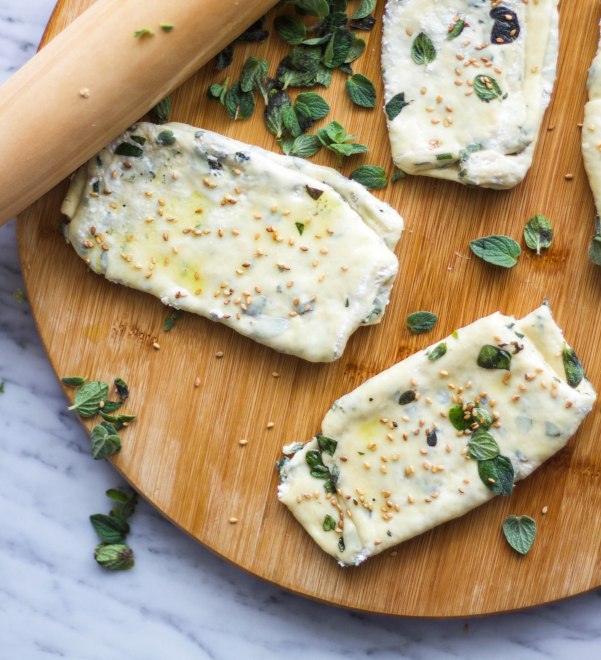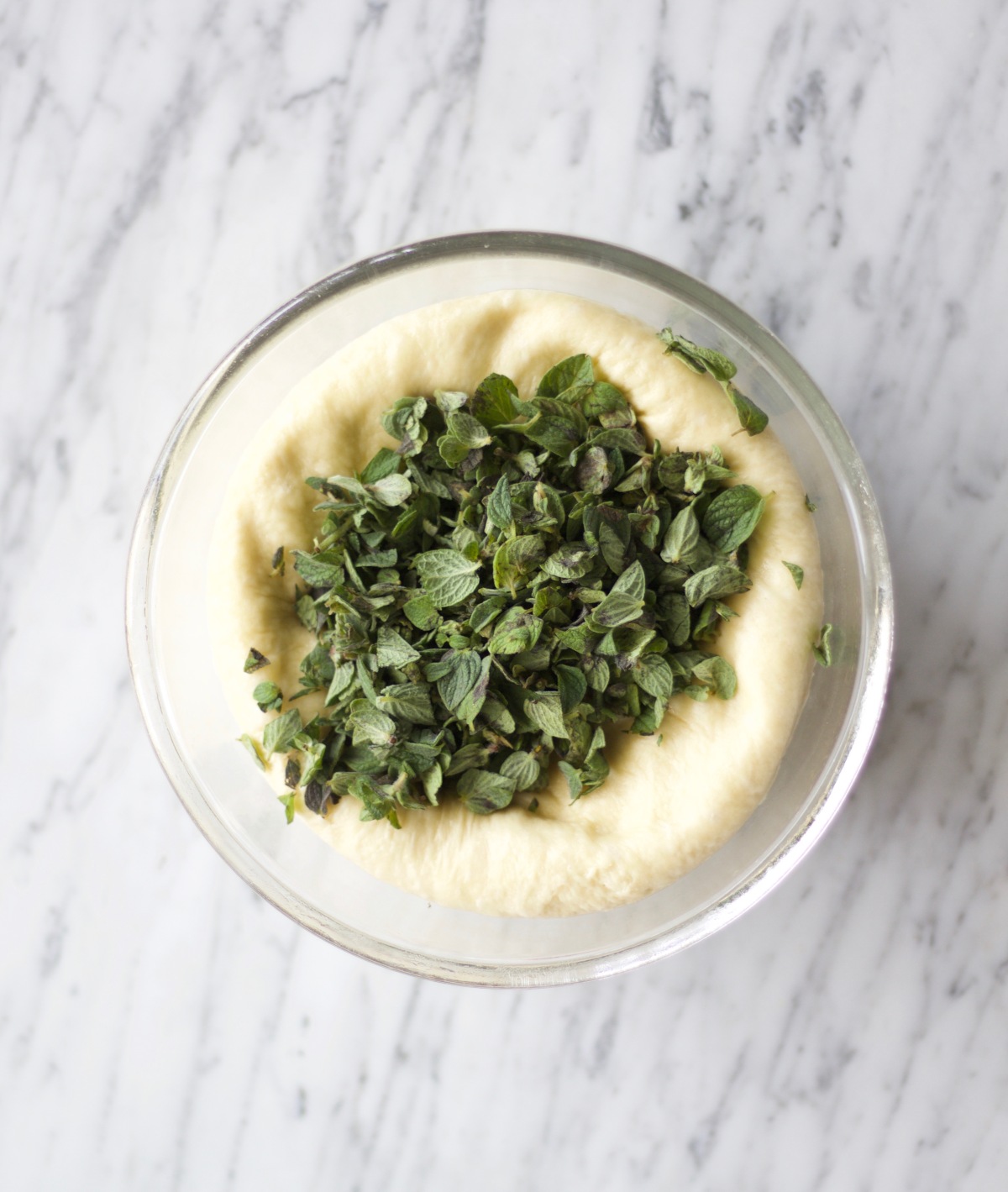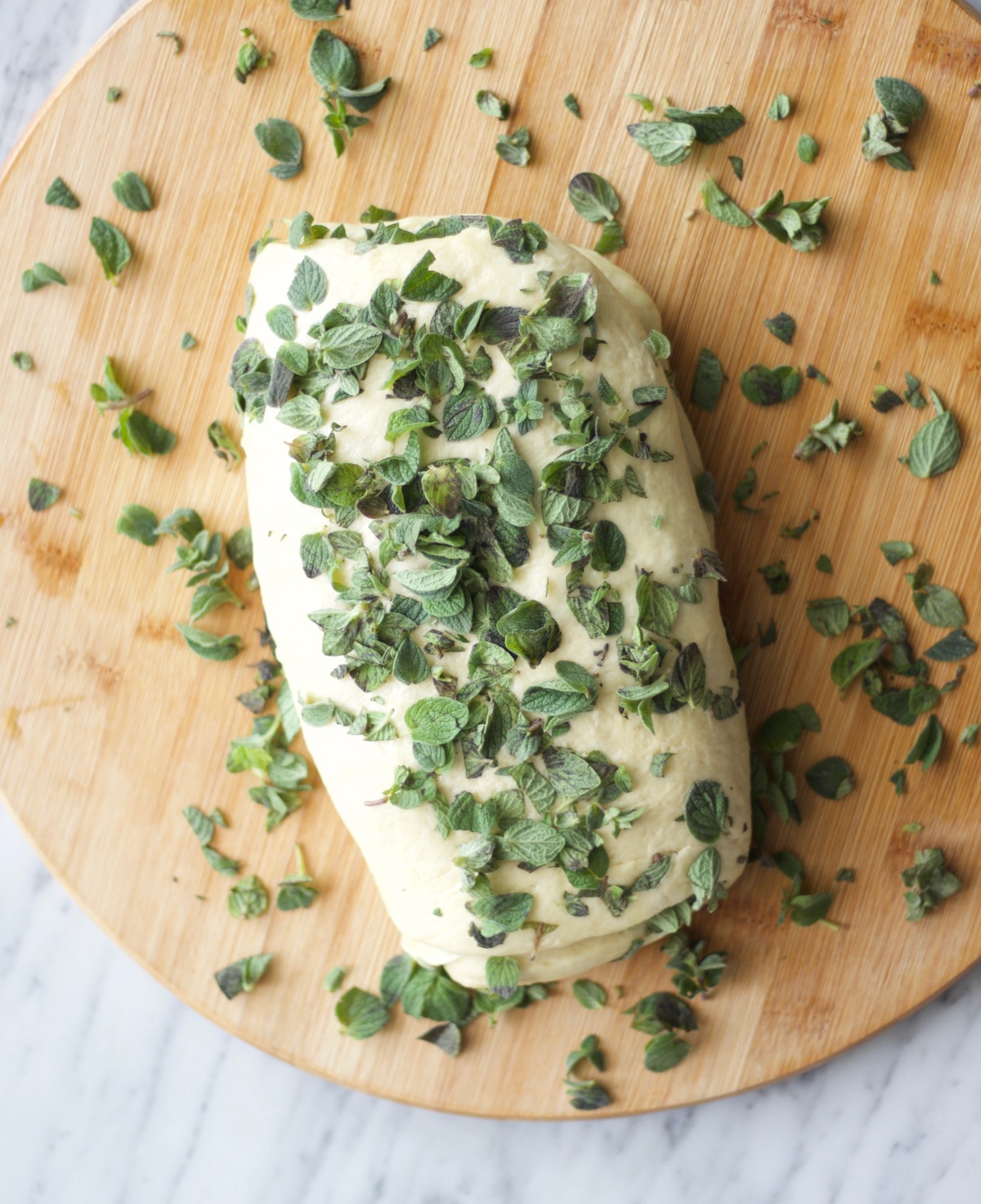
This zaa’tar flatbread is characterized by a rustic combination of olive oil-infused yeast dough, fresh zaa’tar, and goat’s cheese. The herb and cheese are folded into the dough several times in a way that produces layers and layers of goodness.
I love baking, almost more than I love cooking. There is something magical about how a baked good transforms in divine ways in the oven. I also love how almost any bake has the ability to conjure joyful childhood memories. This zaa’tar bread recipe, in particular, takes me to my grandmother’s kitchen. The fragrant smell of zaa’tar that marries with that of fresh bread is something that leaves a lasting impression. Even if you have never enjoyed this particular recipe, the aroma will take you somewhere familiar.
Fatayer zaa’tar is traditionally a Palestinian flatbread infused with olive oil and surely, lots and lots of zaa’tar. Its origins lie in Palestinian villages on mountain tops where fresh zaa’tar is abundant. And the casual description of its origins reflects how its made. This bread is very rustic and difficult to get wrong. There is no need to be precise in measurements when it comes to shaping the dough – the splendor of this bread is in its homemade character. Therefore, take a moment on a long day this winter to relax and visit a faraway place.
This is a recipe that I have improvised over the years until the textures and flavors were just how I wanted them. I tend to prefer a bread that is slightly taller as opposed to the traditional one that is totally flat. If you are more experienced with baking breads, feel free to use a combination of whole wheat and white flours as I often do. I also find that adding goat’s cheese or even a low-moisture mozzarella adds a complementary dimension to this bread. But if you need this to be dairy-free, add some extra zaa’tar — also substitute the yogurt in the dough with water as needed. If you want the bread to be cheesier, add a few chunks in between the individual pieces just before baking. That said, I know fresh zaa’tar can be very difficult to find outside of the Levant. However, it is worth checking out your local Middle Eastern grocer or produce market – you never know who could be growing the valuable herb. Otherwise, use another herb of your choice. A combination of chopped rosemary (or oregano,) kalamata olives, sun-dried tomatoes, and cheese would also be divine here.
P.S. If you give this recipe a try, I would love for you to share it with me on social media. Tag @hanadyskitchen or #hanadyskitchen on Instagram so that I can see your creations! I love connecting and seeing the dishes you’re making. 🙂
Lots of love,
Hanady X


INGREDIENTS/ MAKES 10-12 SMALL BREADS
1/2 cup/ 118 ml. lukewarm water plus a few more tablespoons if needed
2 teaspoons sugar
1 tablespoon instant yeast
4 cups/ 550 gr. strong bread flour or all-purpose flour
1 1/2 teaspoons salt
1/2 cup/ 118 ml. extra-virgin olive oil plus more for kneading
1/2 cup/ 115 gr. plain or Greek yogurt
2 packed cups/ 70 gr. fresh zaa’tar, excess liquid squeezed out, roughly chopped
1 1/2 cups/ 300 gr. low moisture goat’s cheese or mozzarella, cut into small cubes or thickly shredded
METHOD
Begin by proofing the yeast to make sure it is active. Combine 1/2 cup lukewarm water, sugar, and yeast, give the mixture a brief stir, and let sit for about 10 minutes. If the mixture foams up, the yeast is active.
Combine the flour and salt and mix together. Then add the water and yeast mixture, 1/2 cup olive oil, and yogurt. Use a wooden spoon to stir the combination until it comes together into a dough. If it is too dry, add 1 tablespoon of water at a time until the dough comes together. Scoop the dough onto a surface drizzled with olive and knead it for about 10 minutes or until the dough is tight to work with and no longer sticky. You will know you’ve kneaded enough when the dough springs back up when you poke it. Shape into a ball and place seam-side down in a medium bowl greased with olive oil. Cover with plastic wrap and leave to rest in a warm place for 90 minutes. The dough should double in size.
After the dough has risen, preheat oven to 220C/ 425 F and line a large baking sheet with parchment paper. Punch down the dough, add a third of the fresh zaa’tar into the center, fold the dough, and place on a surface greased with olive oil. Roll it out into a large rectangle, add another third of the zaa’ar, fold in half, roll out, and repeat with the rest of the zaa’tar. The herb should be tucked away between the folds. Cut the dough in half and set one of the halves aside, covered with a kitchen towel.
Roll out the half into a rectangle, fold in half, and roll out again. You want the zaa’tar to be well incorporated into the dough. Roll out into a rectangle and scatter 1/4 of the cheese on top. Fold, roll out, and repeat with the other 1/4. Give the dough one more fold and roll out into a rectangle that is about 16-18 inches in length, 8-9 inches in width, and roughly 1/3 inch thick (see method in visuals.) If the cheese or herb is releasing too much liquid and the dough has become difficult to work with, flour your surface and fold another 1-2 times. Be careful not to overwork the dough so that the cheese doesn’t disintegrate. Cut the rectangle in half lengthwise to make two strips of dough. Starting from the beginning of one strip, make a fold of about 1 1/2 inches lengthwise, repeat again to make a roll with 2 folds. Note: this is a good time to add a few more chunks of cheese in between the folds. Cut the edge of the roll with a dough cutter or knife and repeat to make 4-6 more rolls. Be as creative as you like here and fold the dough to a size of your liking – the more rustic the better. Cover the rolls and repeat the steps above with the other half of dough.
Place the rolls onto your baking sheet and flatten just slightly with your hand, depending on how tall or flat you want the bread. Brush with olive oil and sprinkle with sesame seeds if you like. Let sit for 10 minutes and bake in preheated oven for 10-13 minutes or until golden. Brush the baked breads with more olive oil and enjoy warm.
METHOD IN VISUALS













Fantastic! Would be in the kitchen now! Hmm: a wee bit hard to access fresh zaa’tar – shall keep on trying!
LikeLiked by 1 person
A lovely recipe and post. I’m going to make this.
LikeLiked by 1 person
Looks fantastic and yummy 🙂
LikeLiked by 1 person
You’ve gone and hit my soft spot, I love flat bread and this one looks so yummy. I’ve been making my own zaatar with sumac, thyme, oregano, sesame seeds, marjoram and salt. Would this be the same as you’re using in your recipe??
LikeLiked by 1 person
Hi Ron! I’m pleased you liked this recipe. It’s a favorite at our home. I use the fresh herb here, so a combination of fresh thyme, oregano, and even marjoram would be great. X
LikeLiked by 1 person
Thanks Hanady, fresh herbs will be my goal.
LikeLiked by 1 person
You’re most welcome!
LikeLike
Gorgeous! No other word for it 🙂 xx
LikeLiked by 1 person
These are my favourite!
LikeLike